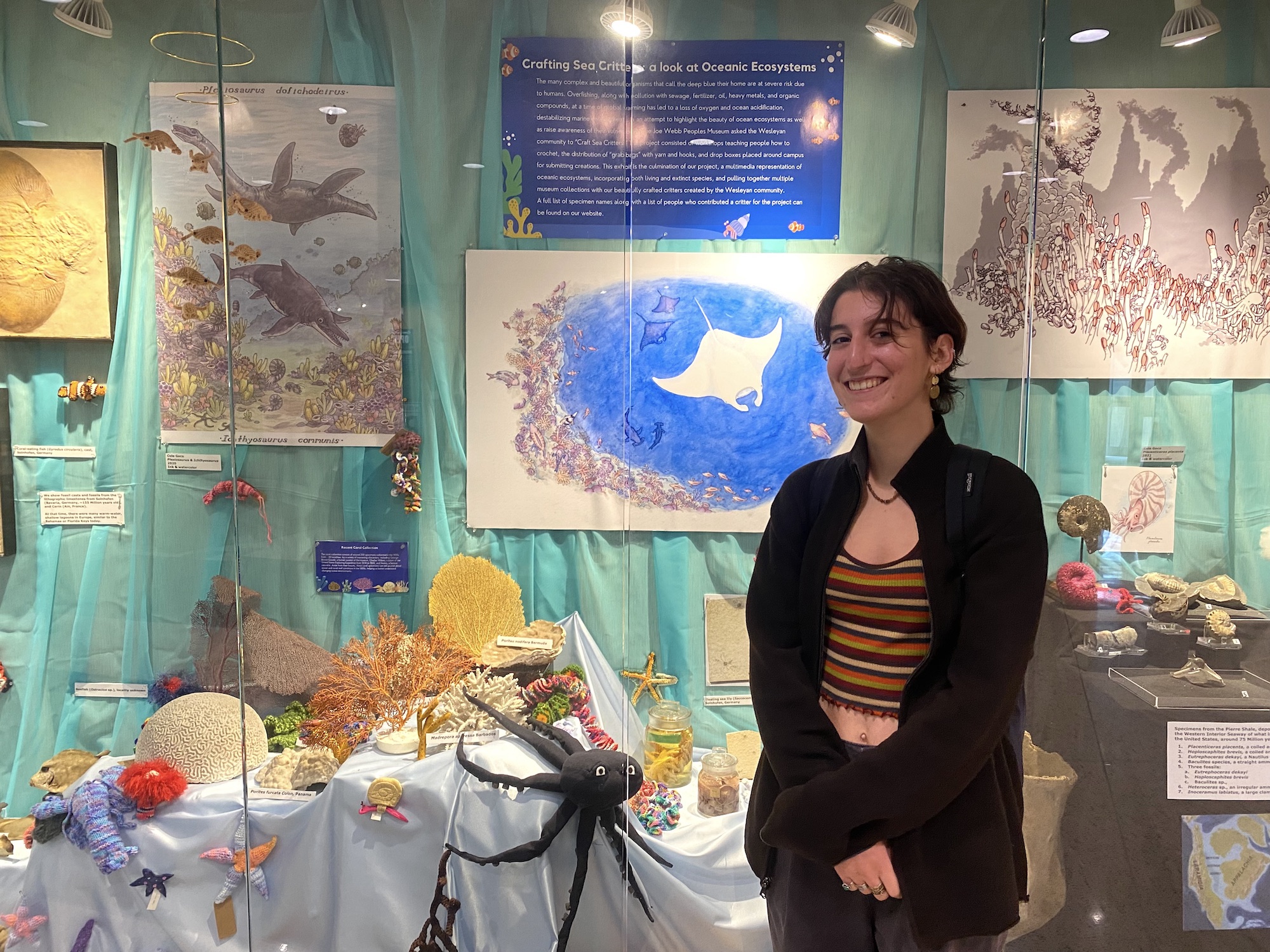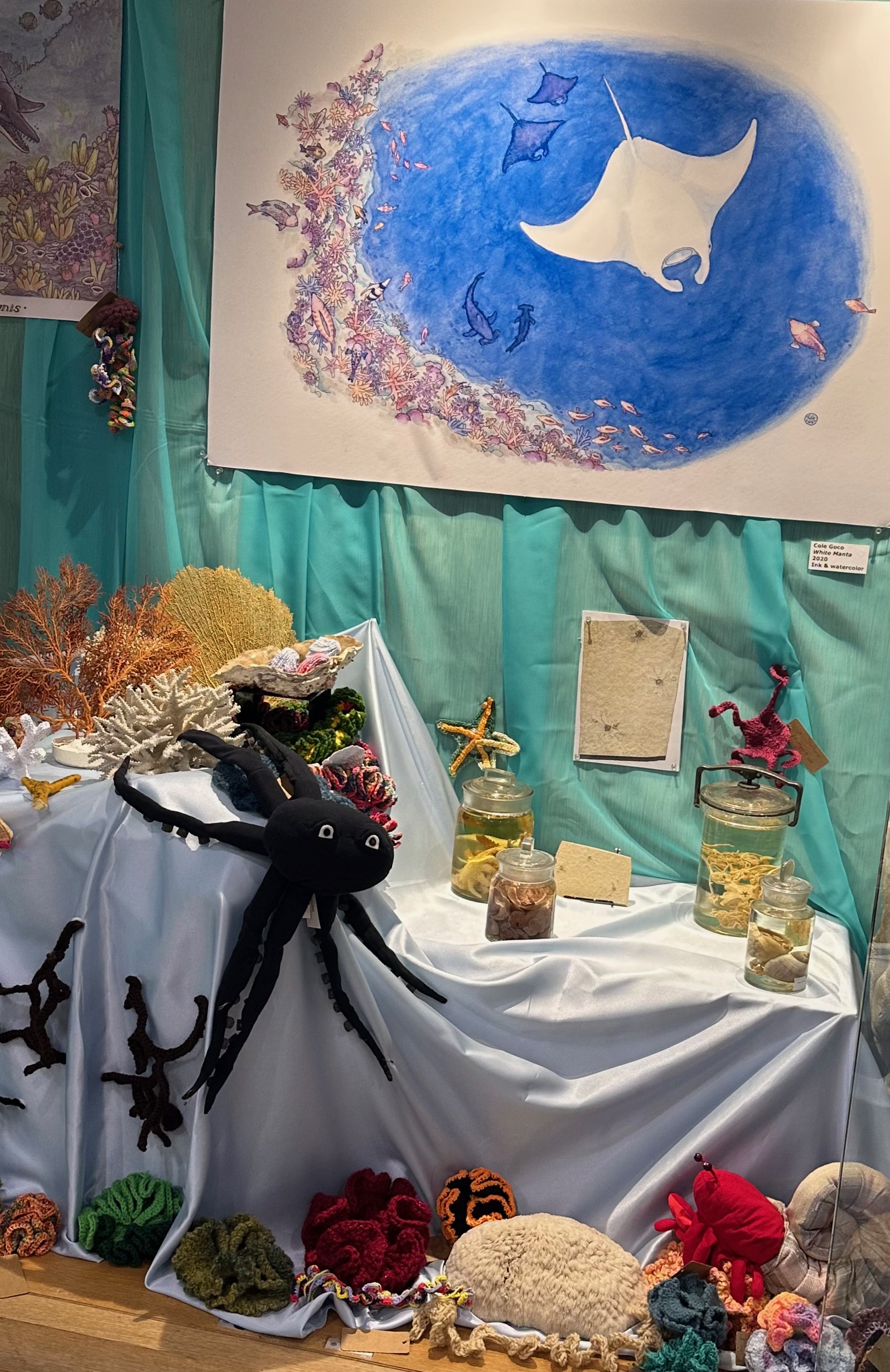
Unapologetically vibrant and dotted with myriad sea creatures, a surreal seascape greets all who walk through the northern doors of Usdan University Center. Crocheted jellyfish perch above coral fossils, stuffed octopi rest on crocheted brain corals, and jars of preserved creatures sit in front of large watercolor paintings of undersea worlds. This multimedia display represents the culmination of the Crafting Sea Critters project and exhibition.
The exhibition is the brainchild of Lily Rudofsky ’25 and professor emerita and Smith Curator of Paleontology of the Joe Webb Peoples Museum of Natural History Ellen Thomas. The initiative aims to showcase the museum’s fossil collections, preserve the art of crocheting, interest students of different academic backgrounds with the sciences, and showcase the fragile diversity of coral reef ecosystems. Its colorful display features original artwork, fossils from the museum’s collection, and sea critters crocheted by many students on campus.
Collections of Critters
According to Rudofsky and Thomas, one of the primary goals of the exhibition is to showcase the often overlooked collection of the Joe Webb Peoples Museum, Wesleyan’s primary collection of natural history artifacts. Students have been working with the museum since 2017 to display the collection’s artifacts in public spaces on campus, especially since the museum’s current home is on the fourth floor of Exley Science Center, far from the Wesleyan public eye. This project and exhibit was born out of one such display initiative.
“One of the museum’s collections is a large number of corals,” Thomas said. “Lily Rudofsky started working with these corals, and so we started to think of ways to exhibit the coral collection together.”
Rudofsky, who works for the museum, emphasized her desire for more students on campus to engage with the museum’s rich specimens.
“I work specifically with the recent coral collection, which is coral from about 200 years ago,” Rudofsky said. “That collection inspired me to do this.… Nine times out of 10, when I tell someone I work with the museum, they go, ‘We have a museum?’ Or they think I’m referring to the art museum.… The fact that most people don’t know about it means that most people don’t have that avenue to explore if they were interested in it. I want to hopefully do my small part in changing that.”
These recent corals that are displayed in the exhibit are a very special collection of fossils due to their young age and impressive history.
“One of the corals in the exhibit right now was collected during the U.S. exploring expedition in 1870,” Rudofsky said. “It was collected under Commodore Charles Wilkes, whose expedition inspired Moby Dick. Not only is that historical importance fascinating, but on the flip side, the corals also tell a story of United States imperialism and the white explorer mentality of going out and conquering and collecting as much as you can without any understanding of the importance or significance of it in its ecosystem.”
By displaying these special corals in a highly interdisciplinary, interactive, and public exhibit, Rudofsky and Thomas expressed that they hope to engage a wider audience on campus with the coral collection, and the museum more broadly.
“Working with the collections, you run into all kinds of topics of interest to different people,” Thomas said. “We can use those collections to have more of an integration across the sciences, humanities and the arts. With this exhibit, some people did artwork, other people worked on websites, other people worked on the exhibit itself. It was a great way for students to collaborate while engaging with the collection, and I hope we can do more of that in the future.”
A major part of the display is original artwork by Cole Goco ’23, a Film Studies and biology major, including large watercolor paintings that line the back wall of the display.
“There are a few artworks that I had made back in high school prior to coming to Wesleyan because I just liked making artwork of ocean ecosystems,” Goco said. “And then there are two artworks that were made specifically for the museum during my time at Wesleyan that are on display.”
Goco also emphasized the importance of the interdisciplinary nature of this project, touching on his experiences working with the museum’s collections as well as creating art.
“I love that there is a mixture of science and creativity on display,” Goco said. “It’s great to have people outside of the very insular museum community contributing stuff to the exhibit. Through this, you can make issues like climate-related ocean issues accessible to all kinds of people at Wesleyan.”

Crocheting on Campus
Another one of the project’s main goals was to teach students on campus how to crochet, involving a sector of students in a science-focused project who might not otherwise engage with natural history-focused exhibitions.
“Lots of crafting skills are slowly getting lost to time, and I think that’s a pity,” Thomas said. “I was talking to Lily [Rudofsky ’25] about crocheting, and we realized that teaching students how to crochet sea critters would be a great way to teach students this old type of crafting while also involving them with the exhibit.”
Rudofsky mentioned that by using project funding to support the creation of crocheted sea critters for the display, students otherwise financially unable to pick up crocheting as a hobby could explore this crafting form.
“Something that I really wanted to do was to get people that wanted to learn how to crochet the opportunity to crochet,” Rudofsky said. “More money got donated recently, specifically for the work that I was doing on the coral collection because of its climate change relevance. So I was like, ‘You know what I could use this funding for? I can give people yarn and hooks to crochet so that if they can’t afford them, they don’t need to buy anything.’”
Rudofsky created crochet kits, each complete with yarn, a hook, and instructions to make a specific type of sea critter, and left these kits at various locations around campus. Students could pick up a kit, crochet a critter, and drop it off at various drop-off locations for their crocheted work to be displayed as a part of the exhibit. Rudofsky also hosted crochet workshops to help interested students craft their critters.
“We had three events: one where we taught people how to crochet brain coral, one where we taught people how to crochet branch coral, and the final one was like a crochet-a-thon.” Rudofsky said. “I got a bunch of people that just sat together for like a couple hours and just made a jellyfish or made a coral. I loved giving people the chance to crochet, and a group to motivate each other, too.”
Environmental Impact
Beyond simply displaying a special fossil collection and making the craft of crocheting accessible to the student body, the exhibit also implicitly highlights current issues with climate change. Rudofsky emphasized the special ability of corals to document changes in the ocean’s climate and pollution levels—one of the reasons they were so interested in displaying them in this exhibit.
“A coral’s calcium carbonate skeleton can tell us a lot about the conditions of the water from where that coral is taken,” Rudofsky said. “It’s like a snapshot of environmental conditions. So using coral samples, you can figure out ocean temperatures at the time the coral was collected.”
Rudofsky said that by exhibiting corals, they hope to bring attention to the environmental impacts that the corals in the collection document, while increasing interest in corals and the fragile ecosystems they are a part of. Exhibit creators hope that showcasing an idealistic, colorful, diverse ocean scene will bring attention to the beauty of this ecosystem, as well as its fragility and precariousness today.
“The concept going into the exhibit was that it was…just a way to celebrate the biodiversity of the oceans,” Goco said. “And by doing that and just having this big sensory overload of how amazing the corals and their ecosystem are, we can just cultivate more appreciation for them and make people consider what we are in the process of losing and destroying.”
Rudofsky emphasized that projects like this involving people outside of insular science-heavy communities are crucial to discussing and addressing climate change as a community.
“I think that a lot of people are scared to get more involved with learning about nature and their relationship to natural environments because a lot of it is through the lens of very sciencey, STEM stuff and equations,” Rudofsky said. “A lot of environmental learning should really instead be thinking about our relationship with the earth, communally, and how we can better exist in that relationship so it’s not so one-sided…and how we can start to repair the ungodly amount of damage that we’ve done to this planet.”
Cole Goco is a Production Manager at The Argus.
Akhil Joondeph can be reached at ajoondeph@wesleyan.edu.



Leave a Reply